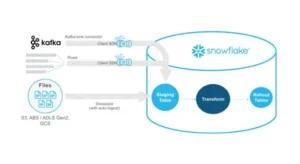
AWS vs Azure: A Comprehensive Comparison of Cloud Services for Data Analytics 2024
As data analytics increasingly integrates into business strategies choosing the appropriate cloud platform is essential.
The two biggest names in the cloud space, Microsoft Azure and Amazon Web Services (AWS) provide powerful tools and services specifically designed for data analytics.
While both platforms offer complete data integration, processing, and analysis solutions, some significant differences between them might affect your decision. The advantages of using Azure and AWS for data analytics projects are compared and contrasted in this article, which also offers insight into how each platform may meet your needs for data integration and analytics.
1. Core Data Analytics Services
While both platforms offer complete data integration, processing, and analysis solutions, some significant differences between them might affect your decision. These differences are critical to consider when evaluating data analytics cloud services that can scale with your organization.
| Data Analytics Service | |
| AWS | Azure |
Amazon Redshift: A fully managed data warehouse designed for extensive analytics. Redshift is renowned for its speed and scalability, especially when managing petabyte-scale data.
| Azure Synapse Analytics: A big data and data warehousing integrated analytics solution. With its integration with Power BI, Synapse enables users to query data using serverless or provided resources for smooth visualization.
|
Amazon Athena: A serverless interactive query tool that lets users use standard SQL to analyze data directly in Amazon S3. Ad hoc data analysis benefits greatly from Athena’s pay-per-query price and user-friendly interface.
| Azure Data Lake Analytics: A distributed analytics solution with massive data processing capacity. Scalable data processing is made possible by the use of U-SQL, a language that combines the advantages of SQL and C#.
|
AWS Glue: Discovering, preparing, and integrating data for analytics is automated using AWS Glue, a serverless ETL (Extract, Transform, Load) service. With its smooth integration with other AWS services, AWS Glue offers a comprehensive data integration solution.
| Azure Data Factory: It is a cloud-based solution for data integration that manages the movement and transformation of data. Data Factory facilitates a range of data sources, making it a versatile choice for ETL processes.
|
Amazon QuickSight: A business intelligence tool that makes it possible to create dashboards, reports, and visualizations. With features like AutoGraph, which suggests the optimal visualizations based on your data automatically, QuickSight is built for speed and scalability.
| Azure Machine Learning: A platform that makes it possible for data scientists and developers to create, train, and deploy machine learning models. Integrating with Azure Synapse and additional Azure data services, it offers an all-inclusive analytics environment.
|
Comparison in 2024
In contrast, AWS provides a wider range of advanced analytics tools that prioritize flexibility and integration. For traditional SQL-based analytics, Amazon Redshift and Athena are very powerful, and AWS Glue makes ETL procedures easier.
On the contrary, Azure Synapse Analytics unifies big data analytics and data warehousing into a single platform, offering a cohesive experience.
Businesses that now use Microsoft’s reporting and visualization ecosystem for their reports can benefit from Azure’s integration with Power BI.
2. Data Integration Capabilities
AWS Data Integration:
- AWS Data Pipeline: An online tool for automating data transformation and transfer. In addition to integrating effectively with other AWS services like Amazon S3, DynamoDB, and Redshift, it is made to perform batch and stream processing.
- AWS Glue Data Catalog: It acts as a central location for all of AWS’s data assets’ data. It improves data discovery and governance by making data easily searchable and queryable.
Azure Data Integration:
- Azure Data Factory: An extensive collection of connectors for integrating with different on-premises and cloud data sources. It also offers versatility in data processing by supporting both ETL and ELT (Extract, Load, Transform) processes.
- Azure Data Catalog: It is a fully managed cloud service that discovers, catalogs, and manages data assets in an organized manner. It facilitates end-to-end data governance through integration with Azure Data Factory and other Azure services.
Comparison
When it comes to offering a wide choice of tools for batch and real-time data integration, AWS excels. Because of the flexibility of the Data Pipeline and the extensive cataloging capabilities of AWS Glue, AWS is a great option for complex data settings.
But with its wide range of connection choices and capacity for managing hybrid settings, Azure Data Factory is a strong choice for organizations with diverse data sources.
3. Machine Learning and AI Integration
AI and ML Services on AWS:
-
- Amazon SageMaker: It is a fully managed service through which Machine learning models may be created, trained, and implemented at scale. The whole machine learning workflow from data labelling to deployment is made simpler with SageMaker.
- AWS AI Services: Consists of an extensive array of pre-configured AI functionalities, including Amazon Forecast for time-series forecasting, Amazon Comprehend for natural language processing, and Amazon Recognition for image analysis.
AI and ML Services on Azure:
-
- Azure Machine Learning: A platform for building, training, and implementing machine learning models. It provides a more efficient workflow for data science projects by integrating with Azure Synapse and other Azure data services.
- Azure Cognitive Services: A set of AI services and APIs that let developers incorporate computer vision, speech recognition, and language comprehension into applications.
Comparison
AWS SageMaker is a popular and extremely flexible machine-learning service that provides all the tools needed for each step of the machine-learning process. Additionally, the extensive suite of AI services offered by AWS offers pre-built features that are simple to integrate into apps.
However, Azure makes it simpler to operationalize machine learning by providing deep connectivity between its machine learning services and other Azure analytics tools.
4. Ecosystem and Integration
AWS Ecosystem:
Azure Ecosystem:
Comparison
Conclusion
Both Azure and AWS provide strong platforms for data analytics, each with advantages of their own.
AWS stands apart by its extensive ecosystem, a full suite of machine learning tools, and advanced adaptable analytics services. For businesses that require significant scalability and integration capabilities, it is a great option.
Azure, on the other hand, stands out for its robust support for hybrid environments, deep integration with Microsoft’s ecosystem, and unified analytics experience.
In the end, whichever you choose—Azure or AWS—will rely on your specific requirements, existing infrastructure, and strategic goals. Organizations exploring data analytics cloud services should carefully evaluate both platforms to determine which best aligns with their business needs and long-term objectives.
If you’re ready to embark on this journey and need expert guidance, subscribe to our newsletter for more tips and insights, or contact us at Offsoar to learn how we can help you build a scalable data analytics pipeline that drives business success. Let’s work together to turn data into actionable insights and create a brighter future for your organization.

How LLMs Are Revolutionizing Text Mining and Data Extraction from Unstructured Data
Leveraging LLMs for Advanced Text Mining and Data Extraction from Unstructured Data Since digital transformation is growing exponentially, businesses generate huge amounts of unstructured data from sources like emails, PDFs,

How Businesses Use LLMs for Competitive Intelligence to Stay Ahead of the Curve
How Businesses Use LLM’s for Data-Driven Competitive Intelligence to stay ahead of the curve Competitive intelligence (CI) is essential for keeping a competitive edge in today’s fast-paced business world. Businesses

Maximizing Cost-Efficient Performance: Best Practices for Scaling Data Warehouses in Snowflake
Maximizing Cost-Efficient Performance: Best Practices for Scaling Data Warehouses in Snowflake Organizations rely on comprehensive data warehouse solutions to manage substantial volumes of data while ensuring efficiency and scalability. Snowflake,

Comprehensive Guide to Implementing Effective Data Governance in Snowflake
Mastering Data Governance with Snowflake: A Comprehensive Guide Data governance is a systematic way to manage, organize, and control data assets inside an organization. This includes developing norms and policies

Efficiently Managing Dynamic Tables in Snowflake for Real-Time Data and Low-Latency Analytics
Managing Dynamic Tables in Snowflake: Handling Real-Time Data Updates and Low-Latency Analytics In this data-driven environment, businesses aim to use the potential of real-time information. Snowflake’s dynamic tables stand out

Mastering Data Lineage and Traceability in Snowflake for Better Compliance and Data Quality
Mastering Data Lineage and Traceability in Snowflake for Better Compliance and Data Quality In data-driven businesses, comprehending the source, flow, and alterations of data is essential. Data lineage is essential
